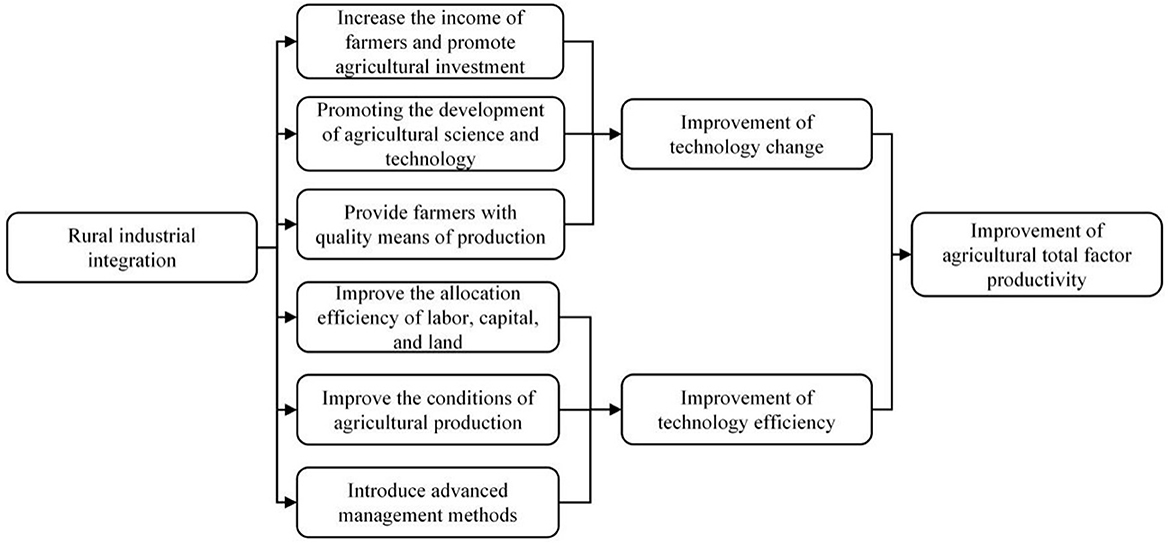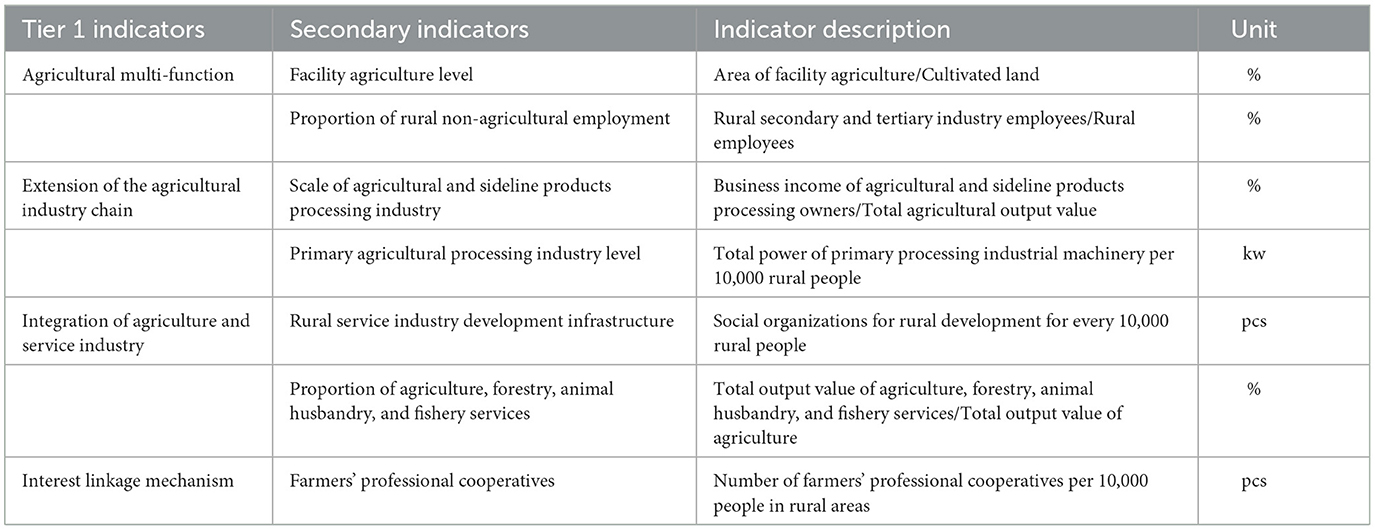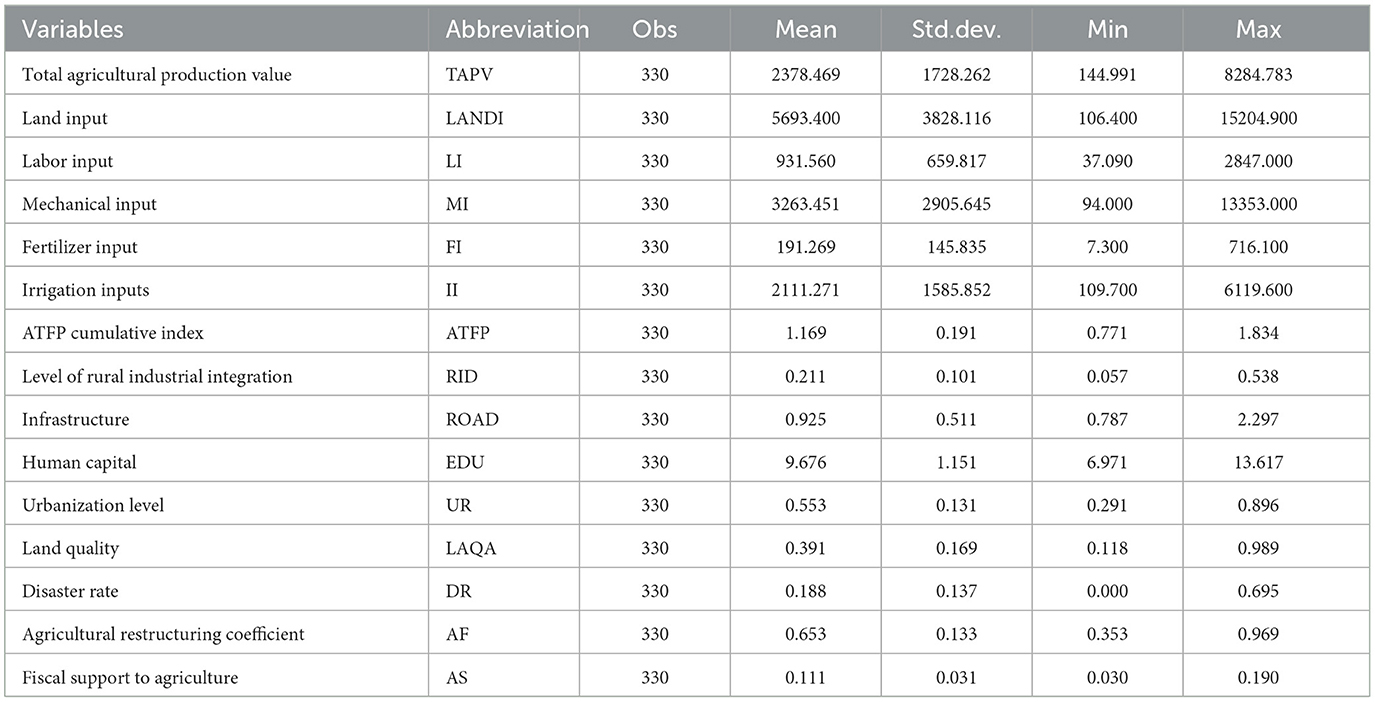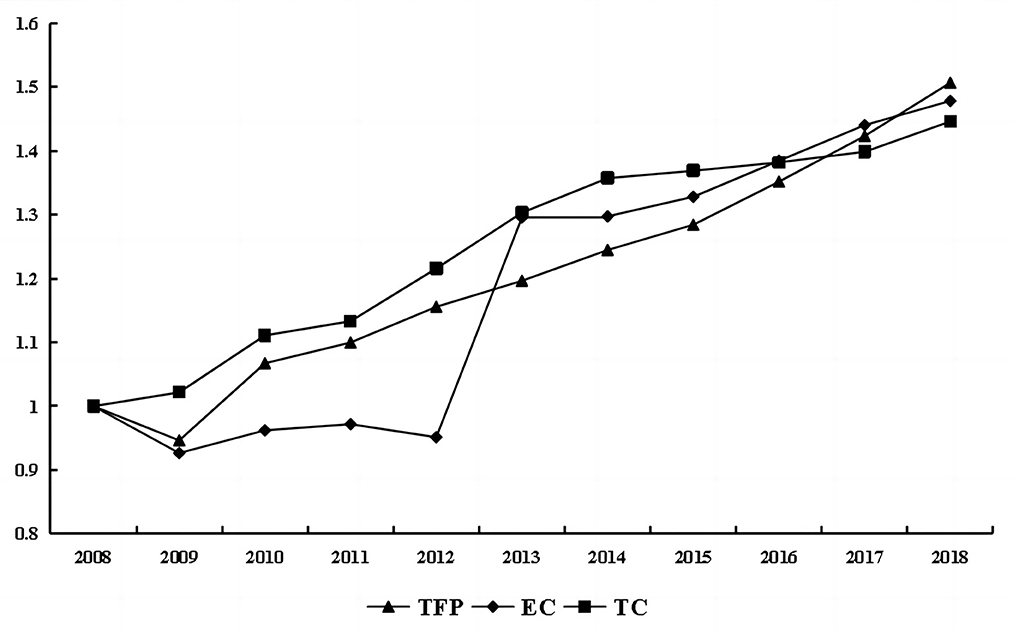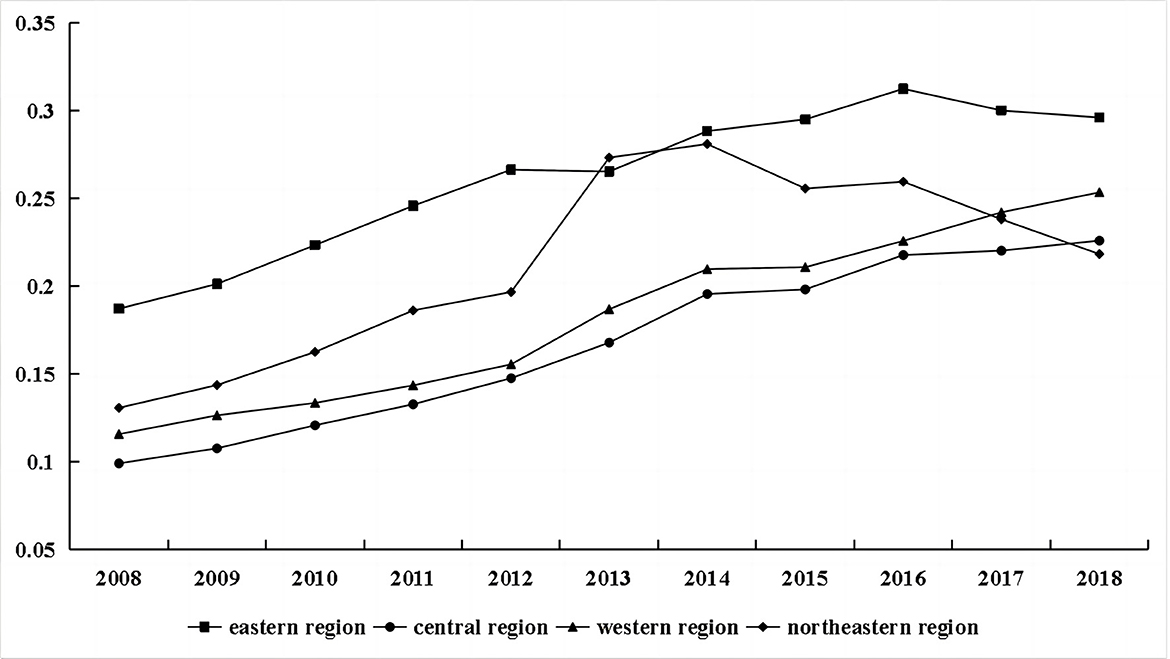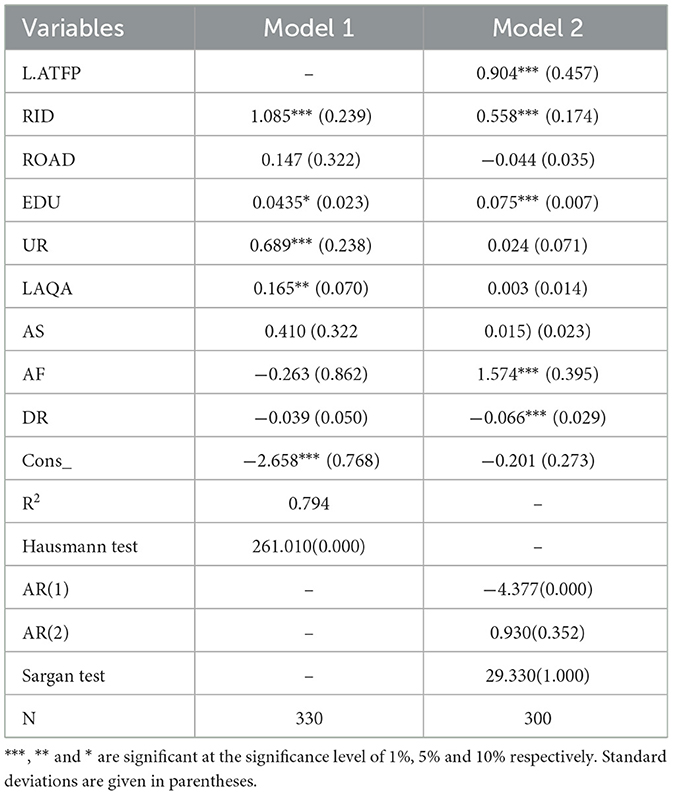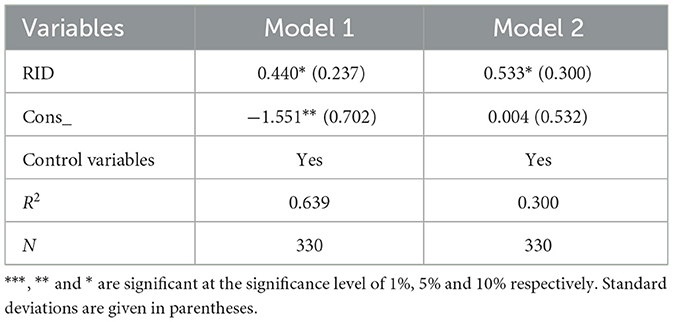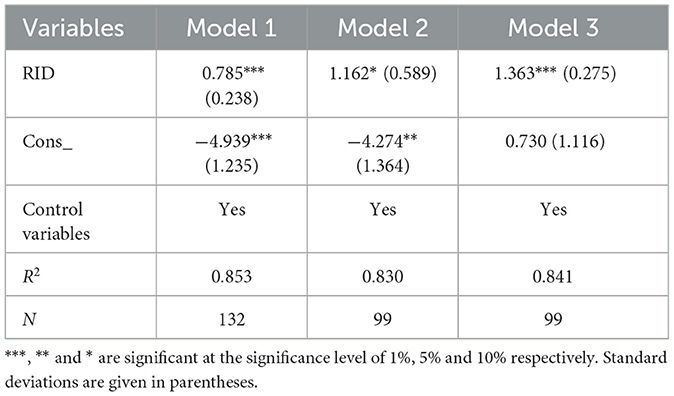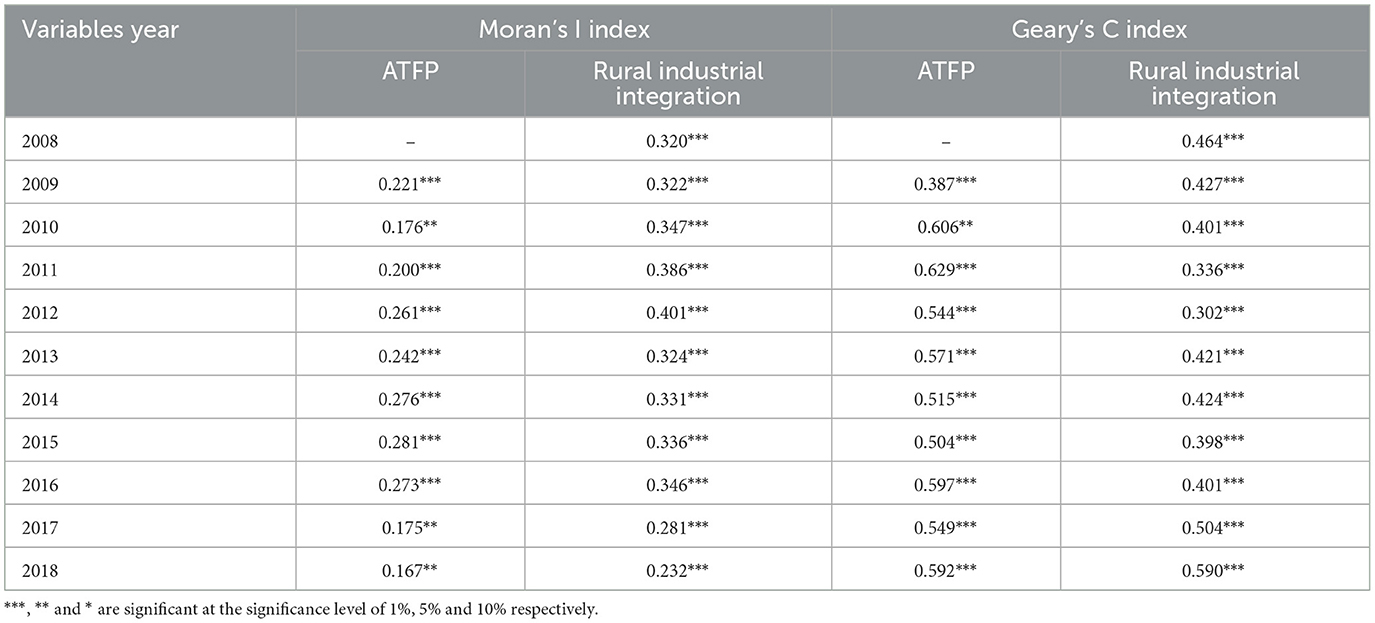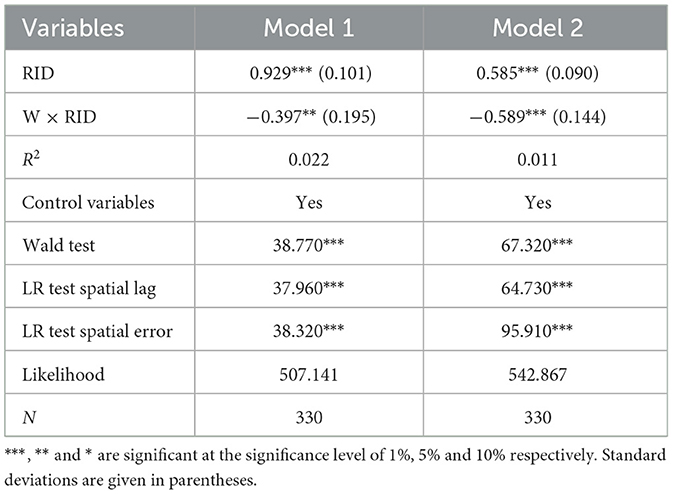- 1College of Economics and Management, Huazhong Agricultural University, Wuhan, China
- 2School of Tourism Management, Wuhan Business University, Wuhan Economic and Technological Development Zone, Wuhan, China
- 3Department of Education, National University of Modern Languages, Islamabad, Pakistan
- 4Business School, Hunan First Normal University, Changsha, China
- 5College of Business Administration, Zhongnan University of Economics and Law, Wuhan, China
Although the literature demonstrates that rural industrial integration can enhance farmers' income, foster rural development, its impact on agricultural total factor productivity (ATFP), a critical aspect of sustainable food systems remains unclear. Using provincial-level data from 2008 to 2018, this paper constructs a composite index of rural industrial integration and examines its effect, heterogeneity, and spatial spillover on ATFP growth in China. The findings indicate that the levels of rural industry integration and ATFP experienced a gradual increase from 2008 to 2018. Rural industry integration promotes ATFP growth through technical progress and improved technical efficiency. An analysis of regional heterogeneity reveals that rural industry integration has the most significant impact on ATFP promotion in the western region, followed by the central region, with the least impact in the eastern region of China. Unconditional quantile regression suggests that rural industrial integration has a more considerable impact on ATFP in regions with higher ATFP. Furthermore, the spatial Durbin model results demonstrate that rural industry integration directly supports rural industry integration development in a region while simultaneously inhibiting ATFP growth in surrounding areas. Finally, the findings also reveal that enhancing rural industrial integration can have positive impacts on sustainable agricultural production in China. These findings offer valuable insights for other developing countries aiming to promote sustainable consumption and production.
1. Introduction
Meeting the food demands of the global population while promoting sustainable agriculture is a major challenge for humanity (Godfray et al., 2010; Springmann et al., 2018). China has been making substantial efforts toward food security and sustainable agricultural development (Huang and Yang, 2017). The growth accounting framework posits that agricultural growth is primarily determined by increases in agricultural factor inputs and agricultural total factor productivity (ATFP) growth (Solow, 1957; Bjurek, 1996). Furthermore, ATFP growth has contributed significantly to China's agricultural growth (Huang and Rozelle, 1996; Jin et al., 2010; Hu et al., 2021). ATFP growth, which includes technological progress, technological efficiency, scale efficiency, and allocation efficiency, is the source of sustainable agricultural development (Beugelsdijk et al., 2018; Ren et al., 2019). Increasing ATFP can increase the supply of food and thus guarantee food sustainability. However, ATFP growth is influenced by many factors, and existing studies generally believe that agricultural policy reform is the decisive factor (Lin, 1992; Kumar et al., 2008; Po et al., 2008; Gong, 2018; Liu et al., 2020). As a result, policy innovation is essential for promoting national agricultural growth.
In recent years, rural industrial integration has emerged as a focus of China's national agricultural policy, emphasized by the Central Government's No. 1 document for six consecutive years (Chen, 2019; Han, 2019). The rural industrial integration refers to the process of organic integration of agricultural production, processing and circulation based on agricultural production, through the horizontal broadening and vertical extension of the industrial chain, multi-functionalization of industries, and agglomeration of elements (Zhang et al., 2020; Xiang et al., 2022). The objective of rural industrial integration is to promote rural development through the integrated use of rural land. This integration can affect rural land use, which may influence ATFP growth (Tian et al., 2020). This relationship is crucial for sustainable agricultural development. Furthermore, rural development through non-farm work opportunities can lead to positive synergies between sustainable agricultural production, off-farm employment and poverty alleviation. Therefore, this paper aims to answer three questions: First, will rural industrial integration promote ATFP growth? Second, will the impact of rural industrial integration on ATFP be heterogeneous? Third, is there a spatial spillover effect of rural industrial integration on ATFP? Answering these questions is essential for China and other developing countries seeking to promote sustainable agricultural development.
The literature relevant to this paper focuses on two main areas: The first is the calculation of ATFP. Currently, there are two primary methods for calculating ATFP: stochastic frontier analysis (SFA) and data envelopment analysis (DEA). The SFA method requires setting a specific production function and is a parametric estimation method (Aigner et al., 1977). In contrast, DEA calculates efficiency through a data envelope and is a nonparametric estimation method (Razzaq et al., 2019). Most literature uses a combination of DEA and the Malmquist index to measure ATFP (Grifell and Lovell, 1995; Tugcu and Tiwari, 2016). Additionally, some scholars have employed the F-P index for ATFP measurement (O'Donnell, 2010, 2012). The F-P index offers multiplicative completeness and transferability compared to the traditional Malmquist index, enabling better calculation and decomposition of multiple individuals' productivity (Fulginiti and Perrin, 1997). The F-P index method has been widely used to measure ATFP in Australia, the EU, and other countries (BaleŽentis, 2015; Baráth and Ferto, 2017).
The second major area of literature concerns the factors influencing ATFP. With the improvement of ATFP measurement methods, numerous studies have begun to focus on the determinants of ATFP, such as human capital, infrastructure, and agricultural policy innovations. Enhancing farmers' human capital enables them to adopt advanced technologies, which significantly increases ATFP (Bachewe et al., 2018). Improved infrastructure can contribute to ATFP by ameliorating agricultural production conditions and increasing the scale of operations (Fakayode et al., 2008; Shamdasani, 2021; Zhang et al., 2022). Agricultural subsidies help farmers increase ATFP by investing more or adopting advanced production technologies (Zhu and Lansink, 2010; Yi et al., 2015). Agricultural policy innovations can promote technological progress and improvements in technical efficiency, thus increasing ATFP. Existing studies suggest that agricultural policy innovations, such as the family responsibility system, agricultural tax reform, and land system reform in China, have played a vital role in ATFP growth (Fan, 1991; Kumar et al., 2008; Gong, 2018).
This study contributes to the literature in three ways. First, little research has been conducted on measuring rural industrial integration. Therefore, we construct a comprehensive index of rural industrial integration based on Chinese government documents, which can serve as a reference for other countries. Second, although existing literature has addressed the impact of rural industrial integration on rural development (Li and Ran, 2019; Zhong et al., 2020; Cao et al., 2022), there is limited research on its effect on ATFP. We systematically analyze the impact and heterogeneity of rural industrial integration on ATFP. Thirdly, as the agglomeration of rural industries, the integration of rural industries is likely to have a spatial effect on ATFP growth. Consequently, we employ the spatial econometrics method to investigate the total effect of rural industrial integration on ATFP growth, exploring both the direct effect and spatial spillover effect.
The overall objectives of this study are to examine the impact of rural industrial integration on sustainable agricultural development and its spatial spillover effects. Specifically, we use ATFP to measure agricultural sustainable development, which is consistent with the approach employed in most existing literature. First, we calculate the levels of rural industrial integration and ATFP in China's provinces. Next, we investigate the impact and heterogeneity of rural industrial integration on ATFP. Finally, we examine the spatial spillover effect of rural industrial integration on ATFP. In summary, our research can provide valuable insights for the sustainable development of agriculture in developing countries.
2. Theoretical framework and hypotheses
2.1. Influence mechanism of rural industrial integration on ATFP
Existing literature (Färe et al., 1994) suggests that ATFP growth arises from improvements in agricultural technology change and technical efficiency. We decomposed ATFP into these two components, and the impact mechanisms are shown in Figure 1.
The first impact mechanism proposes that rural industrial integration promotes technological progress, leading to increased ATFP. The integration of rural industries can improve farmers' incomes (Li and Ran, 2019; Tian et al., 2020; Zhang et al., 2020; Cao et al., 2022), which in turn encourages them to invest more in agricultural production, such as selecting improved varieties and utilizing more machinery (Lazaroiu et al., 2019). This integration fosters agricultural technology progress by facilitating research and development of agricultural science and technology, and by linking the interests of large agricultural companies and small farmers, who provide quality means of production and contribute to technological change (Zhang et al., 2020).
The second impact mechanism suggests that rural industrial integration enhances agricultural technical efficiency, leading to increased ATFP. The integration of rural industries reduces the cost of agricultural information dissemination and breaks down barriers of information asymmetry, increasing land, labor, and capital utilization efficiency (Gambardella and Torrisi, 1998; Xing et al., 2011; Zhou et al., 2022). Additionally, rural industrial integration improves agricultural production conditions and introduces advanced management methods from other industries, such as digital management, further improving technical efficiency.
Based on this analysis, we propose the following hypotheses and illustrate them in Figure 2:
Hypothesis 1-1: Rural industrial integration can increase ATFP growth.
Hypothesis 1-2: The impact mechanisms of rural industry integration on ATFP are technological change and technological efficiency improvement.
2.2. Heterogeneity analysis: impact of rural industrial integration on ATFP growth
The impact of rural industrial integration on ATFP can be influenced by factors such as regional human capital, rural infrastructure development, and the degree of marketization (Li and Ran, 2019; Wang and Li, 2019; Zhang et al., 2020). Therefore, the impact of rural industrial integration on ATFP shows regional differences. In regions with higher human capital, technological innovations brought about by rural industrial integration can be applied to agricultural production more rapidly (Tian et al., 2020; Ye et al., 2020), increasing ATFP more effectively. Good infrastructure, such as roads, networks, and water resources, can better leverage the role of rural industrial integration on ATFP growth (Pocol et al., 2021; Zhou et al., 2022). The impact of rural industrial integration on ATFP is more pronounced in areas with a higher degree of marketization, mainly due to the role of resource allocation (Lǎzǎroiu et al., 2020).
Based on this analysis, we propose the following hypotheses:
Hypothesis 2-1: There is regional heterogeneity in the impact of rural industrial integration on ATFP.
Hypothesis 2-2: The impact of rural industrial integration on ATFP is more significant in areas with higher ATFP.
2.3. Spatial spillover effect of rural industrial integration on ATFP growth
Spatial economics posits that there is a siphon effect in the early stages of economic agglomeration (Ahluwalia et al., 2001). The siphon effect refers to an economy attracting capital, human, and material resources from neighboring regions in the development process, inhibiting economic development in those regions. As a form of economic agglomeration, rural industrial integration may have a siphon effect on ATFP growth, inhibiting growth in surrounding areas. The siphon effect can occur due to rural industrial integration attracting highly qualified labor and capital from neighboring regions (Wang and Li, 2019; Ye et al., 2020), as well as creating a brand effect for agricultural products, which may reduce the competitiveness of agricultural products in surrounding areas, thus inhibiting ATFP growth (Cao et al., 2022).
Based on this analysis, we propose the following hypothesis:
Hypothesis 3: Rural industrial integration has a negative spatial spillover effect, inhibiting ATFP growth in surrounding areas.
3. Methodology and data sources
3.1. ATFP estimation
We calculate ATFP using the Super-SBM model and Malmquist index. The Super-SBM model is effective in evaluating and sequencing multiple fully effective decision units compared to the traditional DEA model (Tone, 2001; Tao et al., 2016; Zhou et al., 2019). The specific setting of the Super-SBM model is as follows:
In equation (1), m and s1 represent the number of input and output variables, respectively. λ represents the weight vector. x0 represents the initial input, x represents the input variable, g and b represent the ordinal number of the output variable, and y0 represents the initial output. The above method can be combined with the Malmquist index to calculate ATFP. We select the global Malmquist index to construct the production frontier, widely used in TFP calculation, as it solves the problem of infeasible solutions in TFP. In addition, the index is able to decompose the ATFP. We can seek the source of ATFP growth by decomposing the index. We use Max DEA to calculate ATFP, which is a software that specializes in calculating productivity.
Calculating ATFP requires selecting input and output variables. Referencing to existing research (Ye et al., 2020), we selected the following agricultural input variables: (1) Land input (LANDI), the sum of agricultural sown area and aquaculture area (thousand square kilometers). (2) Labor input (LI), the number of employees in the primary sector (10,000 people). (3) Machinery input (MI), the total power of agricultural machinery (million kilowatts). (4) Fertilizer input (FI), the number of fertilizer applications (thousand tons). (5) Irrigation input (II), the effective irrigated area (thousand square kilometers). The output variable selected is the total agricultural production value (TAPV), expressed as the total agricultural, forestry, animal husbandry, and fishery output value (100 million yuan).
3.2. Rural industry integration index calculation
The process of measuring rural industry integration in various studies typically involves four steps: indicator selection, indicator normalization, weight measurement, and index formation. In this paper, we develop a concise and scientifically sound index system to measure rural industry integration levels. We accomplish this by analyzing the concept of rural industry integration, incorporating current policy documents, and referencing existing research results (Li and Ran, 2019). The outcomes are displayed in Table 1.
Specifically, we assess rural industry integration across four dimensions: multi-functionality of agriculture, extension of the agricultural industry chain, integration of agricultural service industry, and benefit linkage mechanism. The corresponding secondary indicators include the level of facility agriculture, the proportion of rural non-farm employment, the scale of agricultural by-product processing industry, the level of agricultural primary processing industry, the development infrastructure of rural service industry, the proportion of agriculture, forestry, animal husbandry, and fishery service industry, and the number of cooperatives.
In this paper, we employ the entropy value method to calculate the level of rural industrial integration, following a series of specific steps (Liu et al., 2017).
First, we use the formula below to normalize the data:
Second, we perform a specific gravity transformation on the normalized data using the following formula:
Third, we determine the information entropy value for each index using the following formula:
Fourth, we determine the weight of each indicator according to the following equation:
Finally, we determine the level of rural industrial integration in each province for each year using the following equation:
3.3. Research methods
Building on existing research (Hulten et al., 2006), this paper assumes that agricultural production is influenced by capital, labor, land, technology, and other factors, and establishes the following models.
In the formulas, Y represents agricultural output, RID represents the level of rural industrial integration, γ represents exogenous factors affecting ATFP, and K, L, and M represent physical capital, labor, and land input. A(RID,γ,t) represents the standard Hicks neutral function. Rural industrial integration can increase total agricultural output not only by affecting the inputs of capital, labor, and land but also by affecting A(.). This paper primarily discusses the second way of influence. We suppose that the Hicks neutral function is a multivariate function as follows.
In equation (8), the time variable is t, and i denotes the region. Ai0 indicates the initial productivity level of region i. δ represents the impact of rural industrial integration on ATFP growth. We incorporate the equation 8 into equation 7 and divide f(K,L,M) to obtain ATFP.
We further simplify the logarithm of the expression and introduce control variables as follows:
ATFP is the cumulative rate of R_TFP change. a is the local fixed effect, and μ is the random error term. β and ϕ are the estimated parameters. X is a matrix of the control variables included in the study. Referring to existing studies, we select the following control variables: (1) Infrastructure (ROAD), expressed in terms of road miles per unit area. (2) Human capital (EDU), expressed as the average number of years of education of the regional labor force. (3) Urbanization level (UR), expressed as the ratio of the number of urban population to the total population. (4) Land quality (LAQA), expressed as the ratio of effective irrigated area to sown area. (5) Disaster rate (DR), measured as the ratio of disaster area to total sown area, to control the impact of climate, etc., on ATFP. (6) Agricultural restructuring coefficient (AS), expressed as the ratio of sown area of food crops to total sown area. This indicator can reflect whether the cropping structure of each region evolves toward comparative advantage. (7) Fiscal support to agriculture (AF), expressed as the share of fiscal support to agriculture in total fiscal expenditure.
It is important to note that the dynamic effect of ATFP is not considered in the equation 10. The change of ATFP in the previous year may affect the change of ATFP in the next year. Therefore, we obtain a dynamic panel data model by adding the lagging expansion of ATFP to the equation 10:
To investigate the heterogeneity of the impact of rural industrial integration on ATFP, we perform group regressions for different regional samples based on the equation 10. We then conduct unconditional quantile regressions. Next, we investigate the mechanism of the impact of rural industrial integration on ATFP growth using the following equations:
The equations 12 and 13 represent the effects of rural industrial integration on technical change and technical efficiency, respectively.
Lastly, this paper constructs a spatial Durbin model (SDM) to study the spatial spillover effect of rural industrial integration on ATFP growth.
The weight matrix is w, and the influence coefficients are β, θ, and τ. Furthermore, the equation can decompose the total effect of rural industrial integration on ATFP in space, thus solving the direct effect and spatial spillover effect.
3.4. Sample data
This paper examines a sample of 30 Chinese mainland provinces, autonomous regions, and municipalities for the period 2008 to 2018 for the reason that data related to rural industrial integration calculations have only been available since 2008. Due to data availability, our sample does not include Tibet, Hong Kong, Macao, and Taiwan.
Agricultural input-output data comes from the China Rural Statistical Yearbook and China Statistical Yearbook. Data on agricultural products processing industry and service industry are sourced from the China Agricultural Products Processing Industry Statistical Yearbook and China Agricultural Products Processing Industry Development Report. Data on farmers' professional cooperatives are obtained from regional statistical yearbooks and regional market subject development reports in previous years. Data on facility agriculture come from the National Greenhouse System database. Data on rural development social groups are sourced from the China Civil Affairs Statistical Yearbook in previous years. Data on control variables come from the China Rural Statistical Yearbook and EPS database. Table 2 displays the results of descriptive statistics of the main variables.
4. Empirical results and analysis
4.1. Estimation results of ATFP
Considering potential differences in production frontiers across regions, this paper employs the Malmquist index based on Global, using each province as a Decision Making Unit (DMU) to measure ATFP changes. From 2008 to 2018, ATFP in China exhibited an upward trend with an average annual growth rate of approximately 4.29%, aligning with the findings of other studies (Xu et al., 2019; Sheng et al., 2020; Li et al., 2021). We believe that the improvement in China's ATFP is mainly due to advances in agricultural technology and investments in infrastructure. First, China has continued to innovate in agricultural technology in recent years and has made breakthroughs in the seed industry and other areas. Second, China has promoted infrastructure construction in recent years, mainly high-standard farmland, which has improved agricultural production conditions.
Excluding a few provinces, more than half maintain positive ATFP growth, and growth tends to balance across regions. As the Malmquist index is transitive, this paper converts it into a growth index based on 2008. ATFP results are illustrated in Figure 3. These results demonstrate that ATFP growth in China is determined by both technical change (TC) and technical efficiency (EC). To describe the drivers of ATFP at different time periods, we selected 2012 as the time point because 2012 was the turning point when EC's contribution to ATFP turned from negative to positive. Before 2012, ATFP growth in China was driven by TC. After 2012, both TC and EC contributed to ATFP growth. We believe the likely reason is that China's emphasis on farmer training after 2012 has improved farmers' human capital, which is an important factor contributing to the gradual and rapid growth of EC after 2012.
4.2. Estimation results of rural industrial integration
The average value of rural industrial integration in China between 2008 and 2018 was 0.211, with an overall growth rate of 86.30% and an average annual growth rate of 7.85%. As for specific time trends, the level of rural industrial integration experienced the most rapid increase between 2013 and 2014, growing at a rate of 11.0%. Additionally, there are gradient features in the level of rural industrial integration, with noticeable differences in the development status among the four major regions. The detailed results can be seen in Figure 4. The eastern region consistently maintained a high integration value and led the other regions, with the integration value steadily rising from 0.187 in 2008 to 0.296 in 2018. The northeast region started with a lower integration value, but its growth rate was faster, showing potential to catch up with the eastern region in 2013. However, after 2014, the integration value in the Northeast began to decline. The integration values of the central and western regions were relatively similar each year, but generally, the western regioni was slightly higher than the central region.
4.3. Benchmark regression results
To study the impact of rural industrial integration on ATFP, this paper employs the fixed effect model in panel data ifor regression. Furthermore, the lag(1) of ATFP is included in the regression equation, and the System Generalized Method of Moments (GMM) is conducted for the regression equation. The results of the Sargan test, AR (1), and AR (2) in Table 3 show that selecting the GMM is reasonable.
This paper primarily focuses on the impact of rural industrial integration on ATFP growth. The estimated results of both Model 1 and Model 2 have significantly positive coefficients for agricultural industry integration, indicating that rural industry integration development will increase ATFP, thus verifying Hypothesis 1-1. This is consistent with the findings of existing research (Ye et al., 2020). On one hand, continuous promotion of rural industrial integration optimizes the allocation of agricultural production factors, such as urban and rural labor and land reconfiguration, improving ATFP. On the other hand, rural industrial integration can promote farmers' income, which, in turn, eases financial constraints in agricultural production. Farmers can use this income to purchase more means of production, significantly increasing ATFP.
Model 1 also reveals the effects of other control variables on ATFP. Rural human capital increases agricultural total factor productivity, consistent with existing studies (Liu et al., 2021). Enhanced human capital raises the likelihood of adopting new agricultural technologies. Urbanization has a significant positive effect on agricultural total factor productivity growth, aligning with existing literature (Li et al., 2021), indicating that urbanization can improve agricultural labor allocation between urban and rural areas and promote ATFP. Land quality enhances agricultural total factor productivity, which is in line with existing studies (Ye et al., 2020). In recent years, the Chinese government has invested significantly in improving land quality through projects like high-standard farmland construction, medium- and low-yield agricultural improvement, farmland water conservancy infrastructure, deep plowing and deep pine technology, and farmland fallowing. The implementation of these projects has enhanced land quality in China, increased agricultural ATFP, and ultimately promoted sustainable agricultural development (Gong, 2018). Furthermore, we have not discovered empirical evidence suggesting that infrastructure, agricultural restructuring coefficients, fiscal support to agriculture, or disaster rates have an impact on ATFP.
4.4. Analysis of impact mechanisms
Referring to existing research (Färe et al., 1994), this paper divides the growth of agricultural TFP into technical change (TC) and technical efficiency improvement (EC), and further examines the mechanism of rural industrial integration development on ATFP growth. The results are shown in Table 4. The estimated results of Model 1 and Model 2 represent the impact of rural industrial integration on TC and EC respectively. The coefficients of both model 1 and model 2 in Table 4 are positive and significant, which indicates that the integrated development of rural industries can promote TC and EC. The rural industrial integration accelerates the agglomeration of agriculture-related industries, which is more likely to form agricultural technology innovation and thus promote agricultural technology progress. In addition, the rural industrial integration development can improve the technical efficiency in agricultural production by attracting high-quality capital to the countryside, revitalizing rural land resources, and improving the quality of agricultural labor. In summary, this paper verifies hypotheses 1-2.
4.5. Heterogeneity analysis
4.5.1. Regional heterogeneity analysis
The impact of rural industrial integration development on ATFP always depends on external factors such as resource endowment, economic development and agricultural policy bias. Affected by these factors, the impact of rural industrial integration on ATFP in western, central and eastern China may be significant differences. The fixed effect model is used to estimate the parameters. The results are shown in Table 5. Model 1, Model 2, and Model 3 are the regression results for the eastern, central, and western regions, respectively. As can be seen from Table 5, the regression coefficients for the eastern, central and western regions are significantly 0.785, 1.162 and 1.363, respectively. The coefficients for the eastern, central and western regions gradually increase, which indicates that there are significant regional differences in rural industrial integration on ATFP growth. The growth effect of rural industrial integration on ATFP mainly relies on the natural resource endowment of each region, and the western region can use its abundant natural resources and landmark agricultural product brands to develop leisure and tourism agriculture and agricultural product processing industry, which makes the ATFP growth effect of rural industrial integration in the western region higher than that in the eastern region. In summary, we test hypothesis 2-1.
4.5.2. Productivity heterogeneity analysis
To further explore the heterogeneity of the impact of integrated rural industry development on agricultural TFP growth, we conducted quantile analysis based on the previous empirical evidence. In this paper, the unconditional quantile regression is chosen for estimation, and the results are presented in Table 6. compared with the conditional quantile regression, the unconditional quantile regression does not depend on other variables in the model, and the estimation results can be more reliable (Agyire-Tettey et al., 2018). Models 1-model 5 in Table 6 represent the estimation results for quintiles 10, 26, 50, 75, and 90, respectively. The results show that the regression results are insignificant at quintile 10 and quintile 25, and significant and progressively increasing coefficients at quintile 50, quintile 75, and quintile 90. The results suggest that the effect of rural industrial integration on ATFP is greater in regions with higher ATFP growth. In summary, we tested hypotheses 2-2.
4.6. Spatial spillover effect of rural industrial integration on ATFP growth
The accelerating integration of rural industries will accelerate the cross-regional flow of production factors such as labor and capital, and often bring about spatial spillover effect. Therefore, this paper uses spatial econometric model to further explore the spatial effect between rural industrial integration and ATFP.
4.6.1. Spatial correlation analysis
Before constructing the spatial model, we need to test the spatial correlation of the core variables. This paper chooses global Moran's I index and Geary's C index to test the spatial relevance of ATFP and rural industrial integration. The results are shown in Table 7. As can be seen from Table 7, the values of the global Moran's I index and Gary's C index of the rural industry integration development level and ATFP of China are significantly larger than 0, which indicates that the rural industrial integration and ATFP showed significant positive correlation during the inspection period.
4.6.2. Analysis of SDM results
Before spatial regression, it is necessary to test the rationality of the model. Referring to the existing literature (Wang et al., 2021; Bai et al., 2022), this paper sets three models of SAR, SEM, and SDM respectively, and selects the optimal model by parameters. Firstly, the spatial correlation coefficient is used to test whether there is spatial effect. Secondly, through LR test and Wald test to determine the rationality of SDM model selection. Wald and LR test results show that SDM model is better. Model 1 and model 2 are the results of adjacency matrix and economic distance matrix respectively. From the regression results of SDM in Table 8, we can see that the coefficient of RID is positive, which indicates that the integration of rural industries in this region will promote the upgrading of ATFP. The spatial coefficient of rural industrial integration is negative, which indicates that the rural industrial integration has negative spillover at the provincial level. Based on the above analysis, hypothesis 3 is verified.
4.6.3. Decomposition of spatial effects
The process of rural industrial integration and development will inevitably bring radiation effect, demonstration effect or resource plunder effect in space. In order to further explore the above effects, we will further analyze the effects of rural industry integration on agricultural TFP in the SDM model, including direct effects and indirect effects. In Table 9, the direct effects of Model 1 and Model 2 are positive, which indicates that industrial integration will have a positive impact on local ATFP, which further confirms Hypothesis 3. The negative coefficients of the indirect effects of model 1 and model 2 indicate that the rural industrial integration has a negative spatial spillover effect on ATFP.
5. Discussion
This paper primarily aims to accurately measure the growth of ATTP and the level of rural industrial integration development in China. Furthermore, it investigates the impact, heterogeneity, and spatial effects of rural industrial integration development on ATFP using a suitable model, providing new insights for sustainable agricultural development. The empirical evidence discussed above has led to some intriguing findings.
Firstly, despite fluctuations in China's ATFP from 2008 to 2018, the overall trend was upward, with an average annual growth rate of 4.29%. These findings are consistent with existing literature (Liu et al., 2020; Ye et al., 2020; Li and Lin, 2022) and other studies using DEA to measure trends in ATFP growth. The growth of ATFP can be a good measure of the sustainability of national food production and is widely used as an evaluation indicator of sustainable development. To achieve food sustainability, Chinese agriculture must prioritize improving agricultural economic growth and efficiency while transitioning from a previous growth model to a more intensive one. ATFP, as a central aspect of intensive growth, reflects not only the efficiency of traditional production factor inputs to output but also the contributions and roles of factors like technological progress, technical efficiency improvement, and institutional changes in output growth (Binswanger, 1974; Chavas et al., 2018). In developed countries, agricultural sustainability is primarily achieved through ATFP enhancement. The rapid ATFP growth in China can be attributed to the contributions of agricultural science and technology progress, such as the widespread promotion of quality seeds, organic fertilizers, and biological pesticides. By relying on ATFP growth, China can maximize output with minimal input, given resource constraints—an essential tool for sustainable agricultural development.
Moreover, our study indicates that rural industrial integration effectively contributes to ATFP growth, thus achieving sustainable food production. This finding aligns with existing research (Ye et al., 2020). The results suggest that the government can promote food production specialization by promoting rural industrial integration to ensure food security. As agricultural development faces challenges like overexploitation of resources, overuse of inputs, and groundwater over-extraction, sustainable development becomes increasingly difficult (Razzaq et al., 2022). These issues can be alleviated through rural industrial integration. China's success in this area provides a new path for promoting sustainable agricultural development. In developing countries, breaking the boundaries of rural primary, secondary, and tertiary industries and promoting rural industrial integration are crucial for sustainable agricultural development (Tian et al., 2020). Our study extends existing literature by exploring the mechanisms of action concerning agricultural technological change and improvements in agricultural technical efficiency. We found that rural industrial integration contributes to the enhancement of agricultural technological progress and agricultural technical efficiency. The continuous promotion of rural industrial integration accelerates the agglomeration of agriculture-related industries, which is more likely to foster agricultural technological innovation and promote agricultural technological progress (Zhao, 2019). Additionally, the improvement of agricultural technical efficiency relies on the combined allocation of production factors, and the integrated development of rural industries can optimize the allocation of factors. Specifically, rural industrial integration can improve technical efficiency in agricultural production through paths such as absorbing high-quality capital into the countryside, revitalizing rural land resources, and improving the quality of agricultural labor (Meng et al., 2018).
Furthermore, our study reveals that the impact of rural industrial integration on ATFP has significant regional heterogeneity in China. This effect is largest in the western region, followed by the central region, and smallest in the eastern region. Previous research (Zhang et al., 2020) analyzed the heterogeneity of rural industrial integration's effect but did not elaborate on possible causes. We offer an explanation for these causes. First, the growth effect of rural industrial integration on ATFP relies primarily on each region's natural resource endowment, with the western region utilizing its abundant natural resources and unique agricultural product brands to develop leisure, tourism agriculture, and agricultural product processing industries. This development results in a higher growth effect of rural industrial integration on ATFP in the western region compared to the eastern region (Ye et al., 2020). Second, human capital serves as a bridge for rural industrial integration to promote ATFP. In recent years, China has invested significant funds and policies to aid western development and the accumulation of human capital in western rural areas, such as professional farmer training and family farm recognition. For regions with low ATFP, such as the less developed western regions, the stock of human capital tends to be low. However, increasing its input tends to have a greater incentive effect (Zhang and Hu, 2020). The rural industrial integration for sustainable agricultural development exhibits regional heterogeneity. Therefore, it is essential to develop a heterogeneous model of rural industrial integration for different regions to fully exploit its policy effects.
Lastly, our study found that rural industrial integration inhibits ATFP development in surrounding areas. The essence of rural industrial integration is economic agglomeration, which produces spatial effects. Existing research has begun to focus on the spatial spillover effect of rural industrial integration on farm household income (Abbas et al., 2016; Chen and Yu, 2022). However, few studies have concentrated on the spatial spillover effects of rural industrial integration on agricultural development. We attempt to fill this gap in the literature. We argue that rural integration promotes ATFP development in the region while inhibiting ATFP growth in surrounding areas, which may have a negative impact on food sustainability. Rural industrial integration absorbs talent, materials, and capital from neighboring areas through the agglomeration effect, promoting ATFP growth in the region. However, the loss of high-quality talent and capital from surrounding areas leads to a decline in ATFP, negatively affecting sustainable agricultural development. To promote sustainable agricultural development, appropriate protection policies should be formulated at the early stage of rural industrial integration to prevent the loss of quality resources. We believe that the negative impact of rural industrial integration on ATFP in surrounding areas is temporary, an inevitable occurrence in the early stages of economic development (Li and Ran, 2019; Ye et al., 2020). As rural industrial integration continues to advance, its impact on the periphery will shift from negative to positive. In the process of promoting rural industrial integration, developing countries should implement measures to reduce the initial siphon effect. Through these policy initiatives, we can effectively reduce the negative impact on the sustainable development of food in the surrounding areas during the initial phase of rural industrial integration.
6. Conclusions and recommendations
6.1. Conclusion
Rural industrial integration is a crucial approach to agricultural development and sustainable agricultural production. Studying whether rural industrial integration can enhance ATFP and achieve sustainable agricultural development is an important proposition. This paper measures the level of rural industrial integration by constructing a scientific and concise index system and examines the impact of rural industrial integration on ATFP from two perspectives: heterogeneity and spatial spillover effects. The research results are as follows.
(1) The level of rural industrial integration and the growth rate of agricultural total factor productivity in China are gradually increasing, with average annual growth rates of 7.85% and 4.29%, respectively.
(2) Rural industrial integration can increase ATFP growth. The impact mechanisms of rural industry integration on ATFP are technological change and technological efficiency improvement.
(3) Due to differences in internal and external conditions and resource endowments, there is regional heterogeneity in the impact of rural industrial integration on ATFP, with the most pronounced effects in the western region, followed by the central region and the smallest in the east.
(4) The impact of rural industrial integration on ATFP has a marginal incremental effect. The impact of rural industrial integration on ATFP is more significant in areas with higher ATFP.
(5) Rural industrial integration has a negative spatial spillover effect, inhibiting ATFP growth in surrounding areas.
6.2. Recommendations
Based on the above findings, this paper suggests that promoting sustainable agricultural development should not only rely on the development of rural industrial integration but also develop differentiated rural industrial integration initiatives according to regional heterogeneity and spatial spillover effects. The specific policy recommendations are as follows.
(1) Each region should promote rural industrial integration according to local conditions. Regions should develop specialized industries based on actual local conditions, support regional specialty agricultural products, and improve regional ATFP by combining regional special industries and industrial integration in a reformative and innovative way.
(2) The government should consider the heterogeneity of the impact of rural industrial integration on ATFP and optimize the spatial layout of rural industrial integration development. For China's central and western regions, policies should be implemented to accelerate rural industrial integration development and achieve ATFP growth to catch up with the east. For the eastern regions, the focus should be on the efficiency of integrated rural industry development and enhancing its impact on ATFP growth.
(3) The government should improve and implement policies on talent introduction and investment. As China's rural industrial integration development is still in its initial stage, each region should attract high-quality agricultural producers and capital investment based on their comprehensive conditions to minimize the “siphon effect”.
6.3. Limitations and prospects of the study
Our study provides new evidence to promote food sustainability in China. However, there are some limitations of the article. Limited by the availability of data, the data of our study is only updated to 2018. In future studies, we need updated data to examine the long-term effects of rural industrial integration on ATFP growth. Second, limited by the length of the article, we did not explore the impact mechanism in depth, which is a future research direction.
Data availability statement
The original contributions presented in the study are included in the article/supplementary material, further inquiries can be directed to the corresponding authors.
Author contributions
Conceptualization, methodology, and data curation: FY and SQ. Software and investigation: FY. Validation: FY, QZ, and TT. Formal analysis: FY, NN, and QZ. Resources: FY and LW. Writing original draft preparation: FY, SQ, and TT. Writing, review, and editing: FY, SQ, NN, QZ, TT, and LW. Visualization: FY and TT. Supervision: SQ and QZ. Project administration: SQ, QZ, and NN. Funding acquisition: SQ. All authors have read and agreed to the published version of the manuscript.
Funding
This work was supported by the Late-Stage Funding from the Social Science Foundation of Hubei Province, China (Project No. HBSK2022YB331); Study on the Influence of Toilet Reform Support Policy on Rural Residential Environment Improvement: A Case Study of Changzhutan Area, Hunan Province [Project No. 2022(174)]; You Xiang Jia APP – Sharing Interactive Platform for Rural Culture and Tourism [Project No. (2021)13]. This research was funded by University-Industry Collaborative Education Program, CHINA (Grant No. 220903145231306).
Conflict of interest
The authors declare that the research was conducted in the absence of any commercial or financial relationships that could be construed as a potential conflict of interest.
Publisher's note
All claims expressed in this article are solely those of the authors and do not necessarily represent those of their affiliated organizations, or those of the publisher, the editors and the reviewers. Any product that may be evaluated in this article, or claim that may be made by its manufacturer, is not guaranteed or endorsed by the publisher.
References
Abbas, A., Amjath-Babu, T. S., Kächele, H., Usman, M., and Müller, K. (2016). An overview of flood mitigation strategy and research support in South Asia: implications for sustainable flood risk management. Int. J. Sust. Dev. World Ecology. 23, 98–111. doi: 10.1080/13504509.2015.1111954
Agyire-Tettey, F., Ackah, C. G., and Asuman, D. (2018). An unconditional quantile regression based decomposition of spatial welfare inequalities in Ghana. The J. Development Studies. 54, 537–556. doi: 10.1080/00220388.2017.1296571
Ahluwalia, R., Unnava, H. R., and Burnkrant, R. E. (2001). The moderating role of commitment on the spillover effect of marketing communications. J. Marketing Research. 38, 458–470. doi: 10.1509/jmkr.38.4.458.18903
Aigner, D., Lovell, C. A. K., and Schmidt, P. (1977). Formulation and estimation of stochastic frontier production function models. J. Econ. 6, 21–37. doi: 10.1016/0304-4076(77)90052-5
Bachewe, F. N., Berhane, G., and Minten Taffesse, A. S. (2018). Agricultural transformation in Africa? Assessing the evidence in Ethiopia. World Dev. 105, 286–298. doi: 10.1016/j.worlddev.2017.05.041
Bai, D., Dong, Q., Khan, S. A. R., Chen, Y., Wang, D., Yang, L., et al. (2022). Spatial analysis of logistics ecological efficiency and its influencing factors in China: based on super-SBM-undesirable and spatial Dubin models. Environ. Sci. Pollut. Res. 29, 10138–10156. doi: 10.1007/s11356-021-16323-x
BaleŽentis, T. (2015). The sources of the total factor productivity growth in Lithuanian family farms: a Färe-Primont index approach. Prague Economic Papers. 24, 225–241. doi: 10.18267/j.pep.510
Baráth, L., and Ferto, I. (2017). Productivity and convergence in European agriculture. J. Agric. Econ. 68, 228–248. doi: 10.1111/1477-9552.12157
Beugelsdijk, S., Klasing, M. J., and Milionis, P. (2018). Regional economic development in Europe: the role of total factor productivity. Regional Stu. 52, 461–476. doi: 10.1080/00343404.2017.1334118
Binswanger, H. P. (1974). The measurement of technical change biases with many factors of production. The Am. Econ. Rev. 10, 964–976.
Bjurek, H. (1996). The Malmquist total factor productivity index. Scand. J. Econ. 303-313. doi: 10.2307/3440861
Cao, Q., Zhang, E., and Liu, Z. (2022). Research on policies of rural industrial integration for rural revitalization. Commercial Res. 17, 132–139. doi: 10.13902/j.cnki.syyj.2022.04.004
Chavas, J. P., Shi, G., Nehring, R., and Stiegert, K. (2018). The effects of biotechnology on productivity and input demands in US agriculture. J. Agric. Appl. Econ. 50, 387–407. doi: 10.1017/aae.2018.6
Chen, X. (2019). The core of China's rural revitalization: Exerting the functions of rural area. China Agric. Econ. Rev. 12, 1–13. doi: 10.1108/CAER-02-2019-0025
Chen, X., and Yu, K. (2022). The impact of rural industrial integration on rural residents' income - an empirical analysis based on spatial Durbin model. J. Xiangtan Univ. 46, 66–73. doi: 10.13715/j.cnki.jxupss.2022.02.015
Fakayode, B. S., Omotesho, O. A., Tsoho, A. B., and Ajayi, P. D. (2008). An economic survey of rural infrastructures and agricultural productivity profiles in Nigeria. Eur. J. Social Sciences. 7, 158–171.
Fan, S. (1991). Effects of technological change and institutional reform on production growth in Chinese agriculture. Am. J. Agric. Econ. 73, 266–275. doi: 10.2307/1242711
Färe, R., Grosskopf, S., and Norris, M. (1994). Productivity growth, technical progress, and efficiency change in industrialized countries. The Am. Econ. Review. 234, 66–83.
Fulginiti, L. E., and Perrin, R. K. (1997). LDC agriculture: Nonparametric Malmquist productivity indexes. J. Dev. Econ. 53, 373–390. doi: 10.1016/S0304-3878(97)00022-9
Gambardella, A., and Torrisi, S. (1998). Does technological convergence imply convergence in markets? Evidence from the electronics industry. Res. Policy. 27, 445–463. doi: 10.1016/S0048-7333(98)00062-6
Godfray, H. C. J., Beddington, J. R., Crute, I. R., Haddad, L., Lawrence, D., Muir, J. F., et al. (2010). Food security: the challenge of feeding 9 billion people. Science. 327, 812–818. doi: 10.1126/science.1185383
Gong, B. (2018). Agricultural reforms and production in China: Changes in provincial production function and productivity in 1978–2015. J. Dev. Econ. 132, 18–31. doi: 10.1016/j.jdeveco.2017.12.005
Grifell, E., and Lovell, C. A. K. (1995). A note on the Malmquist productivity index. Econ. Lett. 47, 169–175. doi: 10.1016/0165-1765(94)00497-P
Han, J. (2019). Prioritizing agricultural, rural development and implementing the rural revitalization strategy. China Agric. Econ. Rev. 12, 14–19. doi: 10.1108/CAER-02-2019-0026
Hu, Y., Liu, C., and Peng, J. (2021). Financial inclusion and agricultural total factor productivity growth in China. Economic Modelling. 96, 68–82. doi: 10.1016/j.econmod.2020.12.021
Huang, J., and Rozelle, S. (1996). Technological change: rediscovering the engine of productivity growth in China's rural economy. J. Dev. Econ. 49, 337–369. doi: 10.1016/0304-3878(95)00065-8
Huang, J., and Yang, G. (2017). Understanding recent challenges and new food policy in China. Global Food Security. 12, 119–126. doi: 10.1016/j.gfs.2016.10.002
Hulten, C. R., Bennathan, E., and Srinivasan, S. (2006). Infrastructure, externalities and economic development: a study of the indian manufacturing industry. World Bank Econ. Rev. 20, 291–308. doi: 10.1093/wber/lhj007
Jin, S., Ma, H., Huang, J., and Hu, R. Rozelle. (2010). Productivity, efficiency and technical change: measuring the performance of China's transforming agriculture. J. Prod. Anal. 33, 191–207. doi: 10.1007/s11123-009-0145-7
Kumar, P., Mittal, S., and Hossain, M. (2008). Agricultural growth accounting and total factor productivity in South Asia: a review and policy implications. Agric. Econ. Res. Rev. 21, 145–172. doi: 10.22004/ag.econ.47669
Lazaroiu, G., Andronie, K., and Hurloiu, I. (2019). Trust management in organic agriculture: Sustainable consumption behavior, environmentally conscious purchase intention, and healthy food choices. Front. Public Health. 7, 340. doi: 10.3389/fpubh.2019.00340
Lǎzǎroiu, G., Ionescu, L., Uţǎ, C., Hurloiu, I., Andronie, M., Dijmǎrescu, I., et al. (2020). Environmentally responsible behavior and sustainability policy adoption in green public procurement. Sustainability 12, 2110. doi: 10.3390/su12052110
Li, J., Chen, J., and Liu, H. (2021). Sustainable agricultural total factor productivity and its spatial relationship with urbanization in China. Sustainability 13, 6773. doi: 10.3390/su13126773
Li, J., and Lin, Q. (2022). Can the adjustment of China's grain purchase and storage policy improve its green productivity? Int. J. Environ. Research and Public Health. 19, 6310. doi: 10.3390/ijerph19106310
Li, X., and Ran, H. (2019). How does the rural industrial convergence development affect the urban rural income gap?—Based on the dual perspective of rural economic growth and urbanization. J. Agrotechnical Economics. 17-28.
Liu, D., Zhu, X., and Wang, Y. (2021). China's agricultural green total factor productivity based on carbon emission: an analysis of evolution trend and influencing factors. J. Cleaner Prod. 278, 12020. doi: 10.1016/j.jclepro.2020.123692
Liu, J., Dong, C., Liu, S., Rahman, S., and Sriboonchitta, S. (2020). Sources of total-factor productivity and efficiency changes in China's agriculture. Agriculture 10, 279. doi: 10.3390/agriculture10070279
Liu, Q., Wang, S., Zhang, W., Li, J., Zhao, Y., Li, W., et al. (2017). China's municipal public infrastructure: Estimating construction levels and investment efficiency using the entropy method and a DEA model. Habitat Int. 64, 59–70. doi: 10.1016/j.habitatint.2017.04.010
Meng, L., Zeng, W., and Gan, Z. (2018). Study on the strategy of rural industry development in the central China under the background of urban-rural integration. Asian Agric. Res. 10, 6–8. doi: 10.22004/ag.econ.281767
O'Donnell, C. J. (2010). Measuring and decomposing agricultural productivity and profitability change. Austr. J. Agric. Res. Econ. 54, 527–560. doi: 10.1111/j.1467-8489.2010.00512.x
O'Donnell, C. J. (2012). Nonparametric estimates of the components of productivity and profitability change in US agriculture. Am. J. Agric. Econ. 94, 873–890. doi: 10.1093/ajae/aas023
Po, C., Ming-Miin, Y. U., and Chang, C. (2008). Total factor productivity growth in China's agricultural sector. China Econ. Rev. 19, 580–593. doi: 10.1016/j.chieco.2008.07.001
Pocol, C. B., Marinescu, V., Dabija, D. C., and Amuza, A. (2021). Clustering Generation Z university students based on daily fruit and vegetable consumption: empirical research in an emerging market. Br. Food J. 8, 2705–2727. doi: 10.1108/BFJ-10-2020-0900
Razzaq, A., Liu, H., Xiao, M., Mehmood, K., Shahzad, M. A., Zhou, Y., et al. (2022). Analyzing past and future trends in Pakistan's groundwater irrigation development: implications for environmental sustainability and food security. Environ. Sci. Pollut. Res. 30, 1–17. doi: 10.1007/s11356-022-24736-5
Razzaq, A., Qing, P., Naseer, M., Abid, M., Anwar, M., Javed, I., et al. (2019). Can the informal groundwater markets improve water use efficiency and equity? Evidence from a semi-arid region of Pakistan. Sci. Total Environ. 666, 849–857. doi: 10.1016/j.scitotenv.2019.02.266
Ren, C., Liu, S., Van Grinsven, H., Reis, S., Jin, S., Liu, H., et al. (2019). The impact of farm size on agricultural sustainability. J. Cleaner Prod. 220, 357–367. doi: 10.1016/j.jclepro.2019.02.151
Shamdasani, Y. (2021). Rural road infrastructure and agricultural production: evidence from India. J. Dev. Econ. 152, 102686. doi: 10.1016/j.jdeveco.2021.102686
Sheng, Y., Tian, X., Qiao, W., and Peng, C. (2020). Measuring agricultural total factor productivity in China: pattern and drivers over the period of 1978–2016. Austr. J. Agricultural Resource Economics, 64, 82–103. doi: 10.1111/1467-8489.12327
Solow, R. M. (1957). Technical change and the aggregate production function. Rev. Econ. Stat. 3, 312–320. doi: 10.2307/1926047
Springmann, M., Clark, M., Mason-D'Croz, D, Keith, W, Benjamin, L B, and Luis, L. (2018). Options for keeping the food system within environmental limits. Nature. 562, 519–525. doi: 10.1038/s41586-018-0594-0
Tao, X., Wang, P., and Zhu, B. (2016). Provincial green economic efficiency of China: A non-separable input–output SBM approach. Appl Energy. 171, 58–66. doi: 10.1016/j.apenergy.2016.02.133
Tian, X., Wu, M., and Ma, L. (2020). Rural finance, scale management and rural industrial integration. China Agric. Econ. Rev. 12, 349–365. doi: 10.1108/CAER-07-2019-0110
Tone, K. (2001). A slacks-based measure of efficiency in data envelopment analysis. Eur J. Operational Res. 130, 498–509.S0377-2217(99)00407-5. doi: 10.1016/S0377-2217(99)00407-5
Tugcu, C. T., and Tiwari, A. K. (2016). Does renewable and/or non-renewable energy consumption matter for total factor productivity (TFP) growth? Evidence from the BRICS. Renewable Sust. Energ. Reviews. 65, 610–616. doi: 10.1016/j.rser.2016.07.016
Wang, F., Wang, R., and He, Z. (2021). The impact of environmental pollution and green finance on the high-quality development of energy based on spatial Dubin model. Res. Policy. 74, 102451. doi: 10.1016/j.resourpol.2021.102451
Wang, L., and Li, Y. (2019). The Impact of integrated development of the primary, secondary and tertiary industries in rural areas on farmers' income and its regional heterogeneity. Reform. 310, 104–114. Available online at: https://mall.cnki.net/onlineread/Mall/MallIndex?sourceid=10andcover=1andfName=refo201912$%5E%7Bast%20%7D$1$%5E%7Bast%20ast%20%7D$1$%5E%7Bast%20%7D$ (accessed December 20, 2022).
Xiang, W., Zhu, K., and Teo, B. S. X. (2022). Development Experience and future prospects of the integration of three rural industries in China. Asian J. Social Sci. Studies, 7, 98. doi: 10.20849/ajsss.v7i6.1214
Xing, W., Ye, X., and Kui, L. (2011). (2011). Measuring convergence of China's ICT industry: An input–output analysis. Telecommunications Policy. 35, 301–313. doi: 10.1016/j.telpol.2011.02.003
Xu, X., Huang, X., Huang, J., Gao, X., and Chen, L. (2019). Spatial-temporal characteristics of agriculture green total factor productivity in China, 1998–2016: based on more sophisticated calculations of carbon emissions. Int. J. Environ. Res. Public Health 16, 3932. doi: 10.3390/ijerph16203932
Ye, F., Ma, J., and Hu, Q. (2020). Empirical evidence on the impact of industrial integration development on total factor productivity in agriculture. Statistics and Decision Making. 36, 87–91. doi: 10.13546/j.cnki.tjyjc.2020.10.018
Yi, F., Sun, D., and Zhou, Y. (2015). Grain subsidy, liquidity constraints and food security—Impact of the grain subsidy program on the grain-sown areas in China. Food Policy. 50, 114–124. doi: 10.1016/j.foodpol.2014.10.009
Zhang, L., Wen, T., and Liu, Y. (2020). Integrated development of rural industries and farmers' income growth:theoretical mechanism and empirical determination. J. Southwestern Univ. 46, 42–56.
Zhang, Q., Razzaq, A., Qin, J., Feng, Z., Ye, F., Xiao, M., et al. (2022). Does the expansion of farmers' operation scale improve the efficiency of agricultural production in China? Implications for environmental sustainability. Front. Environ. Sci. 683, 918060. doi: 10.3389/fenvs.2022.918060
Zhang, W., and Hu, Y. (2020). The effect of innovative human capital on green total factor productivity in the Yangtze River Delta: an empirical analysis based on the spatial Durbin model. China Population Res. Environ. 30, 106–120. Available online at: https://kns.cnki.net/kcms2/article/abstract?v=8q8G1i9Uapc2fJGUmiEzeq8AUrH2XsYD5yisoo3xHXUU0Maqw2roxkCEOkDPN8jWfUeRQr5ZElg_Hu-lMdPVd85JYdgfYgh-0fzyfmltfDLmJrSKL0yu-hdtfYEa4IUQ&uniplatform=NZKPT&language=gb
Zhao, X. (2019). Research on the Development of Rural Industrial Integration. Int. Conf. Finan. Innov. Econ. ICFIED 2019, 270–273. doi: 10.2991/icfied-19.2019.51
Zhong, Z., Huang, B., and Li, Q. (2020). The outward and inward of rural industrial integration—Can rural tourism promote agricultural socialization service? J. Agrotech. Econ. 8, 38–50. doi: 10.13246/j.cnki.jae.2020.04.003
Zhou, W., Zhang, Y., and Li, X. (2022). Analysis of the spatial effect of rural industrial integration on farmers' income. Stat. Decision Making 38, 61–64. doi: 10.13546/j.cnki.tjyjc.19.012
Zhou, Y., Liu, W., and Lv, X. (2019). Investigating interior driving factors and cross-industrial linkages of carbon emission efficiency in China's construction industry: Based on Super-SBM DEA and GVAR model. J. Cleaner Prod. 241, 12019. doi: 10.1016/j.jclepro.2019.118322
Keywords: rural industrial integration, agricultural productivity, spatial spillover effects, sustainable production, developing countries
Citation: Ye F, Qin S, Nisar N, Zhang Q, Tong T and Wang L (2023) Does rural industrial integration improve agricultural productivity? Implications for sustainable food production. Front. Sustain. Food Syst. 7:1191024. doi: 10.3389/fsufs.2023.1191024
Received: 21 March 2023; Accepted: 02 May 2023;
Published: 18 May 2023.
Edited by:
Umer Farrukh, Government College Women University Sialkot, PakistanReviewed by:
Xie Jinhua, Lanzhou University, ChinaHaochen Yu, Qingdao University of Science and Technology, China
Copyright © 2023 Ye, Qin, Nisar, Zhang, Tong and Wang. This is an open-access article distributed under the terms of the Creative Commons Attribution License (CC BY). The use, distribution or reproduction in other forums is permitted, provided the original author(s) and the copyright owner(s) are credited and that the original publication in this journal is cited, in accordance with accepted academic practice. No use, distribution or reproduction is permitted which does not comply with these terms.
*Correspondence: Shengze Qin, c2hlbmd6ZXFpbkBmb3htYWlsLmNvbQ==; Qing Zhang, emhhbmdxaW5nMTk4M0B3ZWJtYWlsLmh6YXUuZWR1LmNu
 Feng Ye
Feng Ye Shengze Qin2*
Shengze Qin2* Qing Zhang
Qing Zhang